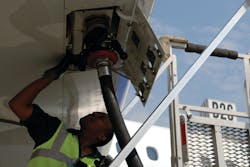A safe operation is the result of many safety interventions. Compare your organizational aviation safety to human health. Doctors say we must exercise, eat the right foods in the right portions, get proper sleep, avoid too much stress, go for an annual check-up and more. These steps to good health must be combined to help ensure continuing health.
For the past six months I have written Ground Support Worldwide articles on such topics as fatigue risk management, professionalism, line operations safety audits, safety management systems and how to calculate a return on safety investments. Each of these topics can have a positive impact to promote safety in your organization.
As in the personal health example, none of these topics stands alone. We must use them collectively to help ensure safety. There are many examples of small programs that add up to ensure your company’s “health.” That health can definitely be measured in safety, but also in efficiency, profit, employee satisfaction and more. Examples of these programs include the following:
- Training
- Voluntary Reporting And Promoting A “Safe” Culture
- Risk Management
- Line Operations Safety Assessment For The Ramp
- Professional Responsibility Awareness
Let’s look at these topics with specific examples:
Training: The FAA worked with a small Miami-based MRO to deliver fatigue awareness training. Questionnaires delivered before the training, immediately after the training and, then, 90 days later were used to determine worker assessment and training impact. Immediately after the training the workers felt that they learned a lot and liked the training. The nature of the single-shift plant with minimal overtime meant that the work schedule did not induce schedule-related fatigue. Workers felt the training reinforced some of their positive sleep habits. Long after the training was over, workers continued to talk about fatigue issues with their peers.
In another fatigue training example, the pre- and post-tests were conducted with airline personnel. There were changes to attitude, knowledge and behavior. Here are the results six weeks after training:
- 44 percent increased sleep by more than one hour.
- 11 percent took naps to supplement sleep duration.
- 55 percent reduced bad fatigue habits, such as drinking caffeine late in the day.
Voluntary Reporting And Promoting A “Safe” Culture: The push for safety management systems has sensitized management and workers to recognize and report the hazards and even the many mistakes that occur daily. They know that such reports result in new programs or changes in procedures that will prevent repeated errors. A culture that encourages workers to speak up when they see hazards or make mistakes is likely a “safe” culture.
An example of successful voluntary reporting is the FAA Aviation Safety Action Program (ASAP). It permits workers to report ordinary errors/mistakes without incurring the wrath of the company or the FAA. The system works. Typically, a new ASAP system receives an increasing number of reports each month, especially in the first six months. This is a sign of progress. The errors did not likely increase, but reporting those errors and, thus, promoting a safe culture definitely did.
Line Operations Safety Assessment For The Ramp: Since the dawn of civilization, workers have taught one another through cooperative work. Line Operations Safety Assessment (LOSA) is a formalized means to observe one another at work. When used properly LOSA identifies both the good and bad work practices as well as hazards. LOSA data can contribute to safety management by identifying risk early – before it becomes an event.
Professional Responsibility Awareness: Have you ever taken the time to talk with workers about professional responsibility at work? Most aviation workers strive to be professional. They understand that their jobs – at nearly every level – are critical to safety. Given the opportunity, they will wear proper uniforms at work. Given the proper education and encouragement, they will use the personal protective equipment. With proper training and work schedules, they will come to work fit for duty.
When companies take professional responsibility, the workers will do the same.
COMPLACENT MANAGEMENT
Unfortunately, there’s a big threat to all these small steps. Let’s say that thanks to a lot of little actions, big things are happening. Event rates are down. All indications are you are running a safe organization.
When the budget is threatened, however, and the safety numbers are high there may be an emerging risk – complacent management. With cost reduction in mind, your management may require you to provide detailed justification for each of your safety interventions. Your management may start asking for an immediate cause and effect for every safety action that you take. Your manager might say: “It’s nice that you trained 10,000 workers on fatigue risk management. Now show me the exact safety improvement. Show me the impact had you not implemented such programs.”
Aside from recommending a safety culture course for the manager, you must find the numbers to answer to these financial questions. The FAA Return on Investment model may help. (See “How To Prove The Value Of Safety,” Ground Support Worldwide, October 2011.)
The article describes new ROI software developed under an FAA human factors project. Management consultant Booz Allen Hamilton Inc. developed the software under contract to the FAA Civil Aerospace Medical Institute.
The goal is to deliver an effective, yet easy-to-use ROI tool into the hands of mid-level management. It has the potential to justify a variety of safety and efficiency interventions including interventions related to human factors. This tool is provided at no cost to the industry. To get started, go to www.mxfatigue.com. That will take you to the ROI program and additional material.
Work hard to quantify results, but be careful to balance the time justifying safety vs. the time implementing safety.
Let’s return to the comparison between human health and aviation safety. Overall heath comes from a combination of lifestyle decisions. Safety, in turn, comes from a combination of programs and activities. You must avoid the slippery slope of reducing interventions when the safety numbers are high. You don’t stop eating right and exercising once you are healthy.
An alternative comparison could be more business-oriented. Consider your small interventions as “internal marketing” for safety. Many who have worked in marketing have seen times when a budget reduction caused a company to cancel participation in a trade show, reduce expenses for print and media advertising, cut product offerings and other such actions.
Often it is only a short time before the sales department sees reduced leads, reduced demand and reduced sales. If reduced sales can be compared to reduced safety, you cannot afford to reduce your combination of small interventions that contribute to overall safety.
Even with extraordinary health or high safety performance, never become overconfident or complacent. One cannot be too healthy or too safe.
Dr. William Johnson has spent more than 30 years as senior executive and scientist for engineering companies specializing in technical training and human factors before joining FAA in 2004. He is also an aviation maintenance technician and has been a pilot for more than 45 years.
‘Little’ Programs Help A Lot To Collect, Analyze And Apply SMS Data
Many of the programs we've discussed can help your organization collect, analyze and apply the three different types of data that comprise Safety Management Systems.
Data Type Definition Collect, Analyze Comments
And Apply Information
|
Reactive |
Event is over. Conduct instigation. |
Traditional event/accident investigation process. |
Learn from the event. Disseminate appropriate information. |
|
Proactive
|
Looking at present data as always. Elevate the application of these data. |
Use audits from the quality, safety and engineering departments. Rely on key performance indicators. Existing systems can include CASS, C.A.S.E., ASAP. |
Improve your methods for capitalizing on these data. |
|
Predictive |
Identify the threats early in the process by increased employee involvement. |
Heavy reliance on voluntary reporting and peer-to-peer assessment. ASAP and LOSA are two examples. |
New attention and investment is necessary for successful predictive data collection and use. |
About the Author

Dr. Bill Johnson
Chief Scientific and Technical Advisor Human Factors in Aviation Maintenance, FAA
““Dr. Bill” Johnson is a familiar name and face to many industry and government aviation audiences. Johnson has been an aviator for over 50 years. He is a pilot, mechanic, scientist/engineer, college professor, and senior executive during his career. That includes 16+ years as the FAA Chief Scientific and Technical Advisor for Human Factors.
Dr. Bill has delivered more than 400 Human Factors speeches and classes in over 50 countries. He has 500 + publications, videos, and other media that serve as the basis for human factors training throughout the world.
Recent significant awards include: The FAA “Charles E. Taylor Master Mechanic” (2020); The Flight Safety Foundation - Airbus “Human Factors in Aviation Safety Award” (2018), and the International Federation of Airworthiness “Sir Francis Whittle Award” (2017).
Starting in 2021 Johnson formed Drbillj.com LLC. In this new venture he continues to bring decades of human factors experience to aviators, worldwide.
